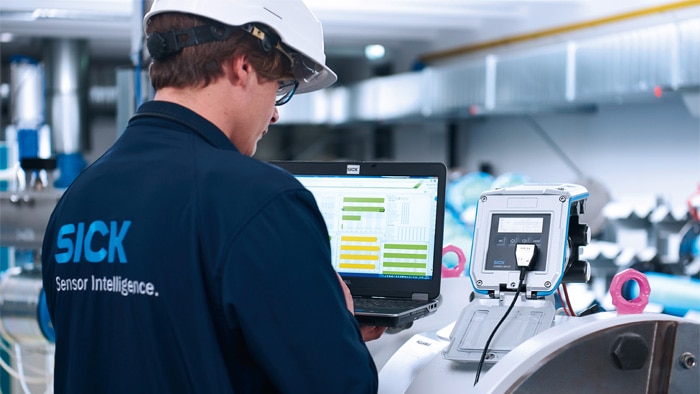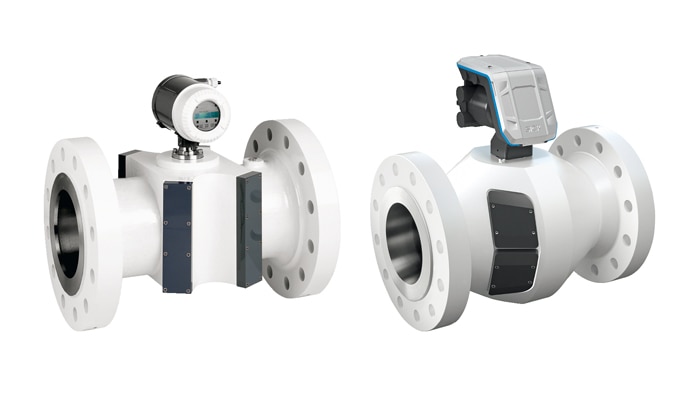A climate-friendly and promising application is emerging for the natural gas network. Operators of gas grids can keep up with the trend to feed, transport and store regeneratively produced hydrogen in existing gas networks – without additional investment in new FLOWSIC gas flow meters. Ultrasonic technology from SICK continues to provide stable measurements in gas infrastructure despite changes in gas properties. Power-to-gas plants also profit from the measurement performance.
Green energy into the gas grid: FLOWSIC continues to measure stable
The need for energy remains high and will even increase worldwide in the next few years. If the energy supply is to remain secure, a smart energy mix must cover the new requirements. The share of natural gas in this mix is estimated to grow to more than 30%. Today its share is about 22%. Renewable energy generated from wind, water, sun and biomass are a priority in the current climate discussion – despite some supply problems. Power generation fluctuates due to changing weather conditions, and the amount generated is not predictable. In addition, there is currently not enough storage space for surplus power from solar and wind power plants. The way out of this dilemma could be the conversion of climate-neutral power into gas generated free of CO2. In the power-to-gas process, green electricity is converted via electrolysis into storable gas, e.g. hydrogen. Methane or synthetic natural gas can also be stored. Producers of fuel cells profit from green hydrogen, and natural gas vehicles move in a climate-friendly manner.
Energy supply with hydrogen
The power-to-gas technology has potential for climate protection and is part of the energy sector just as much as CO2- free generated hydrogen. This hydrogen can certainly also be fed into and saved in existing natural gas networks. The existing gas infrastructures can be used for this purpose. The green energy added to the natural gas is thus used in an economically efficient manner and is available in sufficient quantities at all times. Research teams in the European Union and Asia are examining how reliable the supply in the existing natural gas network is in principle without straining the gas consumers. Process steps are optimized and advanced. The admixture of 5% to max. 25% hydrogen to natural gas is currently considered possible. Also under examination are protection from leakage in existing systems, material compatibility of the pipelines and fixtures, regulation for explosion protection and finally the question of how the calorific value is determined and can be controlled.
Looking at gas flow meters
It is clear that the properties of natural gas change significantly when hydrogen is admixed. Many operating entities of gas networks ask whether this change has a negative effect on the measurement performance of its gas flow meters. Especially in times of cost savings, additional charges are pretty much a no-go. “Of course, when feeding in hydrogen, the measuring devices already installed in the gas grid should still be in good working order,” explains Jörg Wenzel, Head of Product Marketing Services at SICK. “That is why we have taken a close look at the effects of increased admixture of hydrogen on the ultrasonic technology and tested the FLOWSIC gas flow meters for this new requirement. Ultrasonic flow meters from SICK can measure hydrogenous natural gas. Measurement uncertainties which result from the admixture of up to 10% hydrogen are either negligible low or are compensated by the FLOWSIC."
FLOWSIC measures stable, what exactly does that mean?
The gas flow meters from SICK are resistant to hydrogenous natural gas: Electronic housings, electronic adapters and parts which come in contact with media such as ultrasonic sensors, O-rings, flow conditioners, plugs and protective tubes. This is the result of a study by the Federal Institute for Materials Research and Testing (BAM). The changed density and viscosity of the gas mixture as well as the new flow and sound velocity do not influence the reliability and quality of the measurement results of FLOWSIC gas flow meters. A recalibration is also not necessary if up to 10% by volume of hydrogen is fed in. Similar data was published in a technical report in the magazine gwf Gas + Energie in May 2013. At a 20% admixture of hydrogen, the speed of sound probably increases by 10%. The amount of hydrogen admixed in the natural gas is therefore known and the plant operator is informed of the availability of the plant.
Regarding explosions
Hydrogen has a different specific ignitability than natural gas and is in explosion group IIC with stricter requirements on equipment than for natural gas measurements. Explosion group IIA is sufficient for measuring natural gas. In September 2016, BAM – the Federal Institute for Materials Research and Testing – published its report entitled “Safety properties of natural gas/hydrogen mixtures”, looking into the effects of admixing hydrogen with natural gas on explosion behavior and requirements for the explosion group. According to the German Gas and Water Association (DVGW), work is underway to further develop the rules. The new regulation is intended to increase the admixture of hydrogen into the natural gas network to 20% by volume. It is clear based on the current publications, that the electronics and the ultrasonic sensors of the installed FLOWSIC600 and FLOWSIC600-XT gas flow meters from SICK meet the explosion protection requirements for a natural gas mix with 10% hydrogen by volume. Correction is not necessary.
A great deal of commitment with vision
In industry, very different limit values are currently being named for the admixture of hydrogen to natural gas. They range up to 25% by volume. What seems to be clear is that the proportion of hydrogen will increase steadily over the coming years. How quickly this happens will certainly depend on the speed of investment and the progress made with developing power-to-gas technologies. SICK is continuing to study the measuring capability of its ultrasonic measurement devices for hydrogen contents exceeding 25 % by volume and will adapt the gas flow meters if necessary. Operating entities of gas plants can also continue to rely on the precise custody transfer gas volume flow measurement by SICK – and power-to-gas plants as well.
Read more:
More gas for the energy revolution
Safe technology for measuring the concentration of hydrocarbons
Gas and dust measurement: limiting explosions



